Features of the insulated blind area
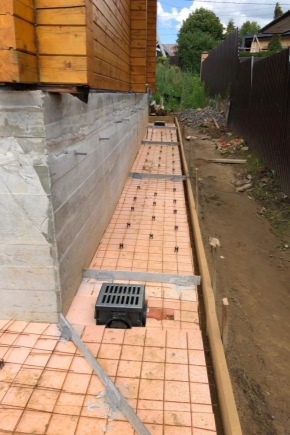
Warmth in the house is the goal of every owner of a private house. Providing a comfortable temperature will depend on various factors, each of which must be taken into account. One of them is the blind area. Often, when creating it, they approach the issue of thermal insulation of this element carelessly. And this becomes the reason for a decrease in the quality characteristics of the finished structure.
Therefore, a good insulated blind area around the house will be extremely important to keep it warm. Let's try to figure out what its design is and what is the technology of its insulation. There will also be a step-by-step instruction on how to insulate such a structure.
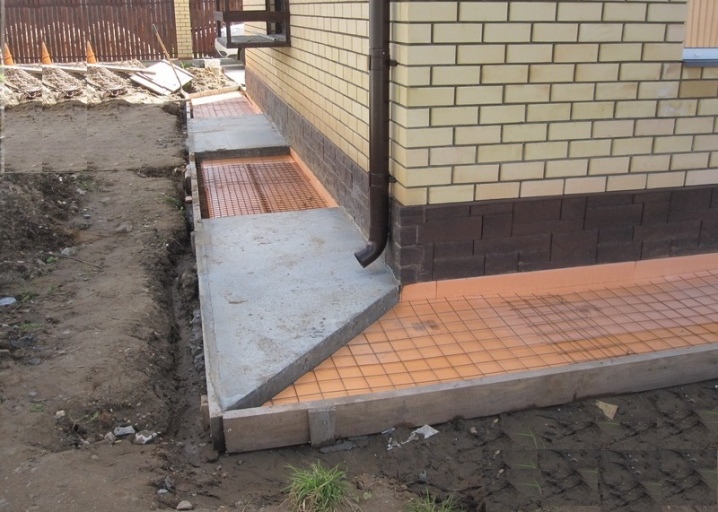
Device
If we talk about the device of the blind area, then it should be said that the concrete blind area itself is not warm. Usually the insulated version has several layers.
- Waterproofing. This layer allows, on the one hand, to retain water, which does not allow it to seep into the ground and thereby have a destructive and negative effect on the foundation of the house.
- A layer of clay. This layer is used to allow moisture to pass through and retain some of it, so that waterproofing can handle the remaining moisture normally.
- Insulation layer. This structural element does not allow the soil to give off cold and take heat away from the building. That is, it is here that the transition to the ground is separated from the ground part. It is required to add that the material is laid not only under concrete, but is located between the wall of the house and the foundation on one side and the blind area on the other. This makes it possible to minimize the heat losses of the building.
- A layer of concrete. This material will already directly form the structure. In fact, this is a node that connects the underground and above-ground parts of this structure with waterproofing.
- A pair of layers of roofing material. They are designed to partially retain moisture, which should have a minimum negative effect on concrete.
- Paving slabs will perform a kind of decorative function and hide the blind area from prying eyes as much as possible.

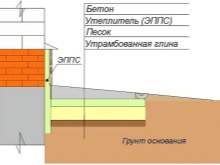
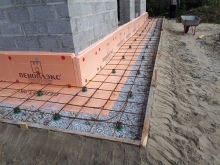
In general, as you can see, the device of the insulated blind area cannot be called complicated. The only thing that should be said is that all the mentioned components that such a cake has must be.
Otherwise, its effectiveness will drop significantly.

Advantages and disadvantages
It is worth noting that the insulated blind area performs quite a few functions. The main, of course, will be the protection of the base of the building from the effects of natural and anthropogenic factors. But other functions should be identified, which can be called advantages:
- protects the soil from freezing;
- does not allow groundwater, snow and rain to have a negative impact on the foundation;
- there is no possibility of saturation of the soil with a large amount of moisture;
- it can act as a track;
- used to drain fluid;
- it is an excellent element of the improvement of the space located near the house.
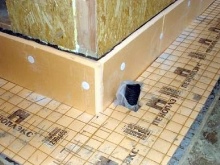
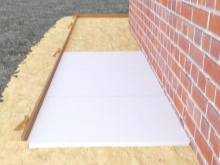
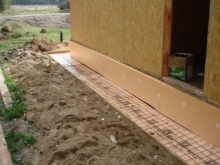
If we talk about the disadvantages of the blind area, then it is worth paying attention to the fact that its main problem, if it is made of concrete, is that it begins to crack a year or two after creation. The reason for this is thermal deformations affecting a closed circuit that is made of inelastic material, that is, in this case, concrete. And from constant narrowing-expansion, it simply cannot be whole for a long time.
Another drawback, if it can be called so critical, will be that often a concrete structure, whether it is insulated or not, is simply bad, if not at all, does not fit into the landscape design of the adjacent territory. And concrete is not the best solution for creating sidewalks due to the fact that cement dust and sand are constantly crumbled from it, which are also brought into the house.
But as you can see, the advantages of such a design will be significantly greater than the disadvantages, and therefore it must be created.
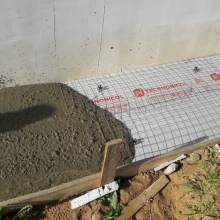

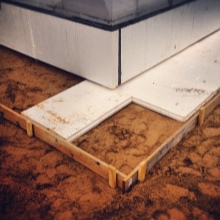
What materials are used?
Today on the market you can find a fairly large number of materials that are used to insulate the existing blind area from the outside. But any material that will be used must meet the following standards:
- have high thermal insulation characteristics and retain heat for a rather long period;
- have excellent moisture resistance characteristics;
- not to lose properties due to exposure to animals and various microorganisms.
Note that not all heaters that can be bought today for insulating a finished blind area correspond to these indicators.
Consider the most common types of insulation.

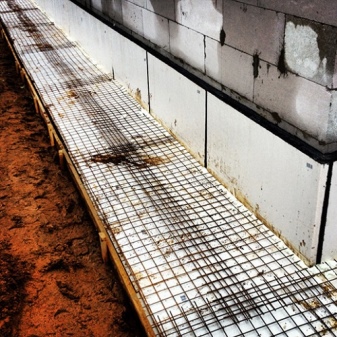
Penoizol
This material can be called a good option for insulating the blind area. It appeared on the market not so long ago, but quickly gained popularity. In fact, it is a polyurethane foam that, after drying, forms an integral layer of material without joints. Its main advantage is its ability to withstand low temperatures.
Its low cost will also be attractive.
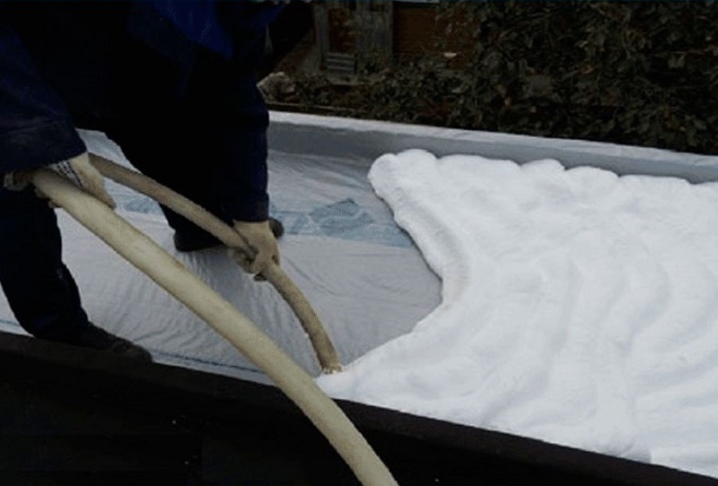
Penoplex
Penoplex can be called one of the most popular materials for insulating a blind area. It stands out among similar materials with the highest characteristics of resistance to moisture, as well as a long service life, which is about 20 years. Besides, its compression ratio is low, which allows it to withstand rather heavy loads.
The mass of the foam boards is quite small. In addition, the material is environmentally friendly and is highly resistant to high temperatures. It is also convenient in that it has a tongue-and-groove docking system, thanks to which it can be used even by people who have not previously worked with similar materials.
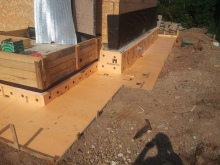
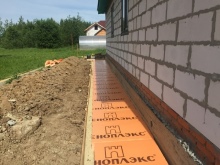
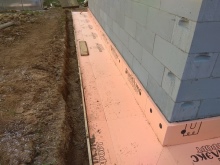
Expanded polystyrene
One of the best solutions for creating thermal insulation of the blind area can be called polystyrene foam. This material is most often used when other types of insulation cannot normally perform the task assigned to them. Usually this is typical for places that are characterized by a high level of humidity. Extruded polystyrene foam is distinguished by a mass of positive qualities, among which it should be emphasized:
- long service time;
- relatively light weight;
- high resistance to fire;
- lack of liquid absorption;
- good resistance to low temperatures;
- excellent resistance to stress;
- environmental friendliness.
If we briefly talk about how to make an insulated blind area using this material, then the scheme will be simple. It is enough to install 50 mm thick sheets in two layers or a 100 mm thick slab in one layer. The sheet joints should be covered with a special strength polyethylene film, which should be laid on top.
It should be added that this material also perfectly resists the effects of chemicals.
All this allows him to effectively carry out his work up to 40 years.
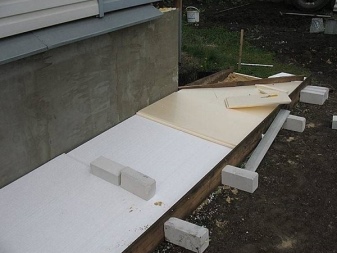

Polyurethane foam
This type of insulation has become popular due to one unique characteristic - it can be applied to any surface.The material is especially popular in the construction of houses. Its advantages:
- has an integral structure without any gaps and holes;
- does not conduct heat well, which in our case will be a serious plus;
- the material is not subject to decomposition and destruction;
- it can be used over a wide temperature range;
- it perfectly resists the effects of fire;
- the material does not absorb water and moisture well;
- well resists biological effects.
True, there is an important point when creating an insulated blind area with the help of polyurethane foam - one of the components from which it is made is toxic.
For this reason, you should be careful.
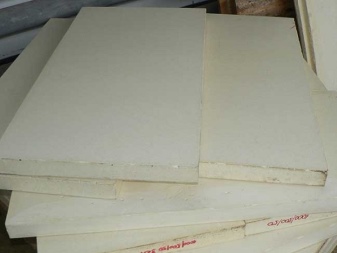

Expanded clay
This type of insulation has good characteristics, and its cost cannot be called high. The material looks like small round granules. They are made from sintered clay. Expanded clay is characterized by low weight and excellent thermal insulation properties.
The disadvantage of this material can be called a high moisture content, so work should be carried out with an additional layer of high-quality waterproofing agent.
Raw materials can be sold both in bulk and in packaged form.
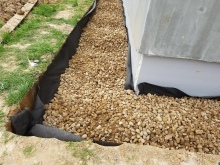

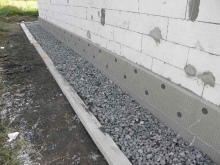
How to do it yourself?
It must be said that to implement the insulation of the blind area, you do not need to have serious construction skills to do it yourself. You just need to understand the algorithm, know some norms and have the following tools at hand:
- hammer;
- drill;
- screwdriver;
- shovels (shovel and bayonet);
- marking cord with a set of pegs;
- electric concrete work;
- manual device for ramming or vibrating plate.
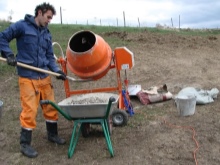

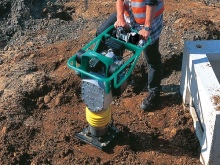
The actual work algorithm will look like this.
- First, you need to carry out the markup of the future structure, determining the tape width. This can be done by lowering the perpendicular from the overhanging roof edge to the ground and stepping back outward at least 500-600 millimeters. Then, at the right distance, you will need to drive stakes into the ground and pull a cord between them.
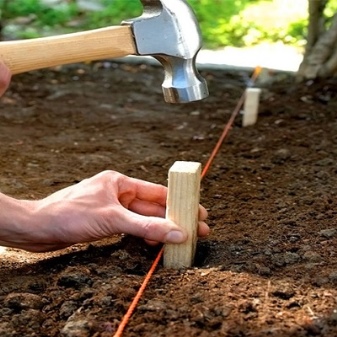
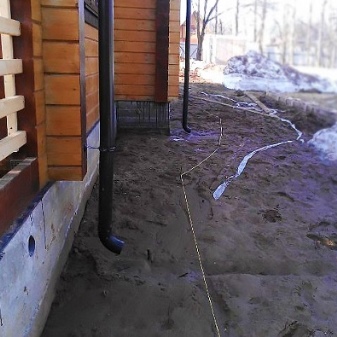
- Now it is necessary to carry out the most labor-intensive actions - land work. Remove the earth from the foundation to the lace to a depth of no less than half a meter if plate-type materials are used. This can be done using the simplest entrenching device. If expanded clay is used as insulation, then the level of land removal increases to 80 centimeters.

- In the lower part of the trench, which turned out, a hydraulic lock should be provided. It is best to use the most common clay. To do this, cover it with a layer 10 to 15 centimeters thick and compact it well. If, in the places where the work is being carried out, the soil is clay or loamy, then you just need to tamp the bottom of the trench.
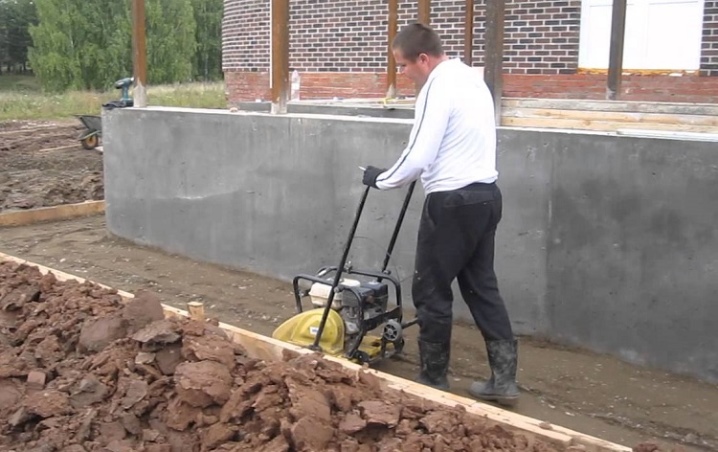
- It is imperative to lay a layer of geotextile on the clay layer, which will prevent mixing of the next layersand will also prevent weeds from growing. A layer of sand of 20 cm thickness should be poured onto the geotextile layer, taking into account the slope of the building, after which everything should be leveled, moistened and tamped according to the entire area in a couple of passes. If required, rainwater gutters and receivers are installed in the layer.
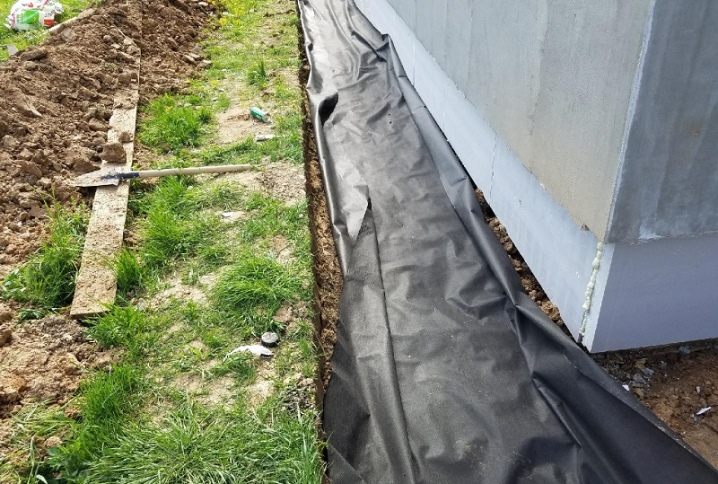
- Now it is necessary to lay the type of insulation material that was chosen. For slab views, it will be better to make a base with flawless flatness. If a deflection is found, then the slabs must be removed and covered with sand. When everything became clear with the width of the insulation layer, plates can be purchased. It would be better to divide the required thickness by 2 and buy such slabs of material so that you can put thin sheets in 2 layers. In this case, when inserting sheets, the joints should be overlapped so that the upper row hides the joints of the lower row of sheets. This will make the insulating layer really high quality and highly effective.
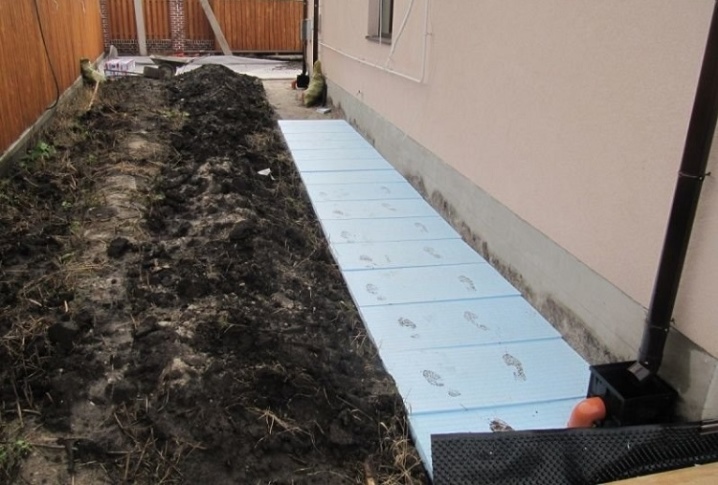
- After that, you will need to strengthen the resulting blind area. To do this, you can use either a ready-made iron mesh, or one made with your own hands right at the place of laying. The size of its cells may vary, but the best option would be a size of 15 by 15 centimeters. To fix the connections, you will need welding, knitting wire or special plastic clamps, which can be purchased at a special store. The mesh should be laid on supports made of stones or bricks, leaving a gap of about 10 millimeters from the mesh to the top of the formwork.
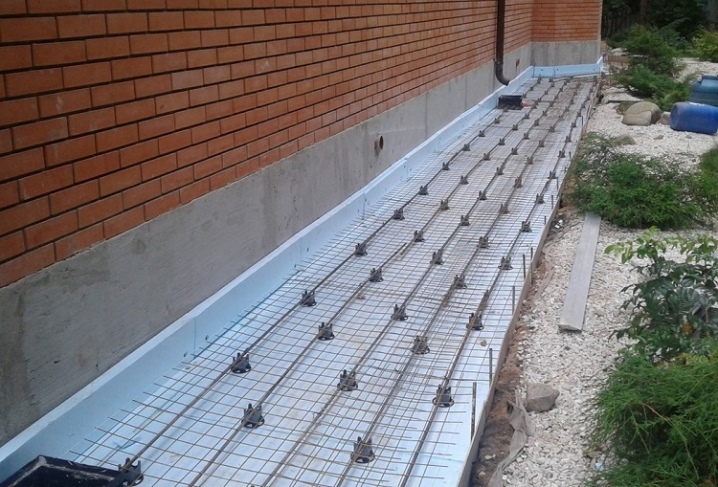
- Now you need to prepare the concrete solution. After that, it is carefully and slowly poured into the formwork. To make sure that all the cells of the network are filled and all the oxygen bubbles are out, the concrete mass should be pierced with an iron rod or a special device called a "vibrator" should be used. After that, you will need to fill the holes that have arisen with concrete. Note that concrete, which is of high quality, will begin to set in about a day, and it will fully acquire its properties after about 30 calendar days.

- When the concrete hardens completely, you will need to start laying the topcoat that was chosen earlier. This is done to decorate the blind area. The most popular types of coating in this case are usually colored clinker-type tiles or paving slabs.
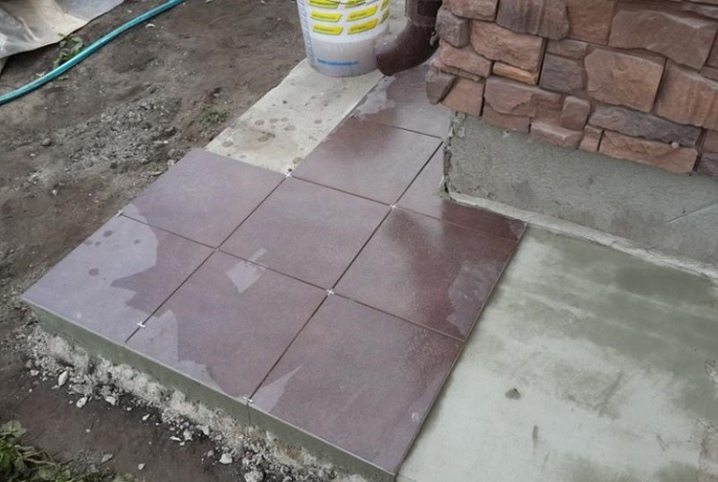
For more information on the insulated blind area, see the video below.













The comment was sent successfully.